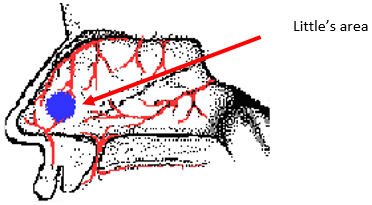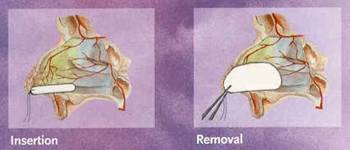See also
Resuscitation
Acute pain management
Key points
- Usually due to minor trauma or friable nasal mucosa
- Try simple measures to stop bleeding first
- Effective resuscitation is vital if circulation is compromised
- Seek early ENT opinion if bleeding is severe or difficult to stop
Background
Epistaxis in children is usually from Little's area (see diagram), which is on the septal wall anteriorly. The bleeding is usually venous, is of brief duration and is often recurrent.
The two most important factors in childhood epistaxis are:
- minor trauma - from nose picking, rubbing, sneezing, coughing or straining
- friable nasal mucosa - from upper respiratory tract infection, drying of mucosa, intranasal steroids
Rarer causes include foreign bodies, nasal polyps, bleeding diatheses, vascular malformations, and nasopharyngeal tumors.

Assessment
History
Consider underlying diagnosis / cause if:
- recurrent or frequent episodes
- easy bruising
- past history of bleeding after surgical challenges (eg dental extractions, tonsillectomy, circumcision)
- family history of bleeding, menorrhagia, recurrent epistaxis
- medication eg NSAID's, nasal sprays
Examination
- Airway - assess for airway compromise (eg if facial trauma)
- Breathing
- Circulation
- assess site of bleeding (if able)
Management
Investigations
- often not needed in epistaxis unless positive history for above
- if circulation compromised or probable history of underlying bleeding diathesis:
check haemoglobin, haematocrit, group and hold / crossmatch, coagulation screen
Treatment
If signs of shock refer to Resuscitation
Guideline
Try simple measures first to stop the bleeding:
- child should be sitting up with head in comfortable position (eg on parent's lap)
- tilt head forward slightly
- apply continuous pressure on the anterior portion (cartilage) of the nose with thumb and forefinger for 10 minutes (see diagram below)
- child should breathe through the mouth and allow any blood to run in to a kidney dish rather than swallowing
.jpg)
If this stops the bleeding, the child can be discharged. See discharge information
If persistent bleeding:
- often due to inadequate treatment / pressure
- determine the site of bleeding
- if bleeding remains uncontrolled, cautery or packing may be required
Cautery
Consult a senior doctor if cautery is required.
Do not attempt under the age of four years as it is unlikely the child will cooperate.
Cautery procedure video
- haemostasis
must be achieved first via pressure / vasoconstrictors
- have the child lying down (sedation not recommended
due to risk of inhalation of clots or packing / local anaesthetics)
- use Cophenylcaine spray (not under 2 years
old), or topical lignocaine 1% with adrenaline 1:100,000 (0.3 mL/kg max
3mg)
- allow time for the local anaesthesia to work
(can take up to 10 minutes for the spray, may require initial spray in to
nose followed by spray on to cotton ball applied directly to bleeding
site)
- have
a good headlight (use the Lumiview if available)
- chemical
cautery can be achieved by applying the tip of the silver nitrate stick to
the bleeding site
- overzealous
cautery can result in ulceration and perforation
- silver nitrate sticks
may not require moistening with water. Excessive moistening may lead to
silver nitrate solution running and staining the nares
If these measures stop the bleeding, see discharge information below.
If these measures fail, nasal packing may be required.
Anterior nasal packing
If site of bleeding known, insert unilateral anterior nasal pack.
Bilateral anterior packing or any posterior packing should not be attempted without ENT consultation.
The easiest form of anterior packing is to use a prefabricated nasal tampon eg Merocel®.
- coat with water soluble gel, grasp the string end with fingers or forceps
- gently and quickly insert along the floor of the nasal cavity until the string reaches the nose
- if packing hasn't expanded in 30 seconds, irrigate with 10mL of saline or water
- tape the string to the nose and trim ends

If unilateral anterior packing stops the bleeding, discharge home and review in 48 hours. Moisten with saline prior to removal and provide discharge information.
Consider consultation with local paediatric team when:
Discuss with ENT if:
- severe or persistent bleeding
- bilateral anterior packing or posterior packing is required
Consider transfer when:
Children requiring care beyond the level of comfort of the local healthcare facility.
For emergency advice
and paediatric or neonatal ICU transfers, call the Paediatric Infant Perinatal
Emergency Retrieval (PIPER) Service: 1300 137 650.
Consider discharge when:
Bleeding has stopped.
Parents provided education on ongoing management and management of recurrence (see below).
Discharge information
- if
simple measures are used to stop bleeding discharge with education on
management at home and preventative measures (no nose blowing for one
week, no nose picking)
- if
there is crusting and the mucosa appears infected, consider treatment with
a topical antibiotic ointment (eg Mupirocin)
- if
dry cracked mucosa contributing, petroleum based gel (eg Vaseline)*
should be applied daily in the morning until healing. Use twice daily for
one week if cautery or packing was required
- for frequent
recurrences consider ENT review as an outpatient
* There is a risk of chemical pneumonitis if petroleum based gel is
inhaled - long term use should be avoided.
Parent Information sheet
Nosebleeds
Last Updated March 2019